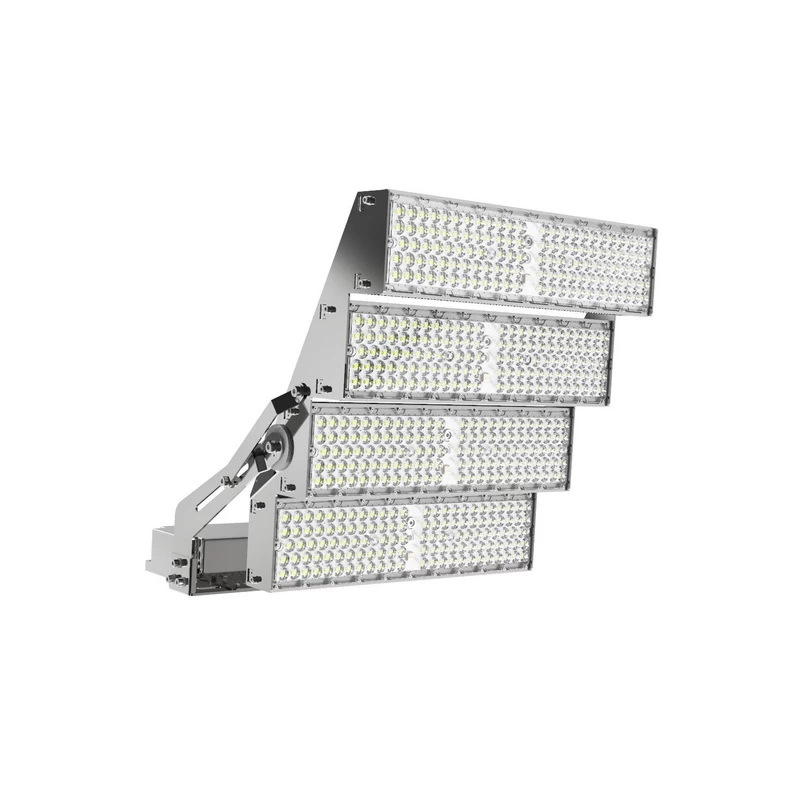Table of Contents
Toggle1. Do LED Lights Attract Bugs?
Bugs and LED lights have always been closely related. LED lights are often marketed as being less attractive to bugs than traditional lighting options, such as incandescent bulbs or fluorescent lights. While it is true that LED lights attract fewer insects overall, they are not completely bug-proof. The key factor behind bug attraction is the type of light emitted and the heat produced by the light source. To understand why bugs are attracted to LED lights, we must consider a few essential factors, such as light intensity, heat emission, and the color of the light emitted.
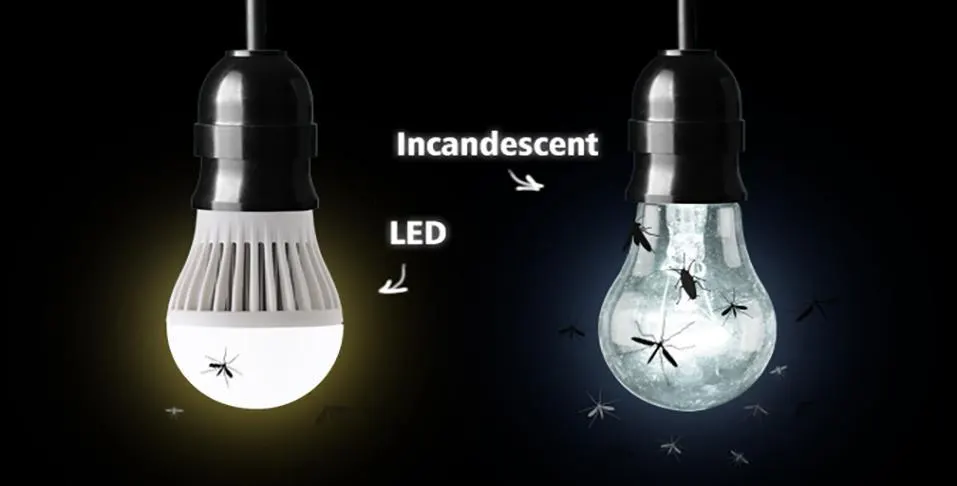
Why do LED lights attract fewer bugs?
Unlike incandescent lights, which emit a broad spectrum of light that includes ultraviolet (UV) and infrared radiation, LED lights primarily emit light within the visible spectrum. Insects, particularly bugs like moths and beetles, are highly sensitive to UV light. Since most LED lights emit very little UV radiation, they are less attractive to bugs. However, bright LED lights can still draw insects, especially if placed in outdoor areas where insects are naturally attracted to light sources.
One reason LED lights are preferable in settings like factories, commercial buildings, ports, and stadiums is their ability to produce less heat compared to traditional lights. Insects are often drawn to the warmth of traditional light bulbs, but operating temperature of LED lights is relatively low, reducing the attraction. However, in some cases, bugs and LED lights can still interact, especially if the LED lights are particularly bright or if they are in the blue or white light spectrum.
2. Does Red Light Attract Bugs?
Insects are rarely attracted to red light. Their visual systems are primarily sensitive to the following wavelengths:
- Ultraviolet light (UV, approximately 350–400 nm)
- Blue light (approximately 450 nm)
- Green light (approximately 530 nm)
Red light, with wavelengths exceeding 600 nm, is nearly invisible to them, much like we are insensitive to infrared light.
Learn more about wavelengths and colors.
If you want to use lights in outdoor places such as balconies or campsites but are afraid of attracting insects, red light is an ideal choice.
Practical Application:
- 🌾 Agricultural Pest Control Lighting: Using red light can prevent insects from damaging crops.
- 🏕️ Outdoor Camp Lights: Red light will reduce the presence of flying insects.
- 🏠 Indoor Night Lights/Sleep Lights: Using red or warm light will neither disturb sleep nor attract insects.
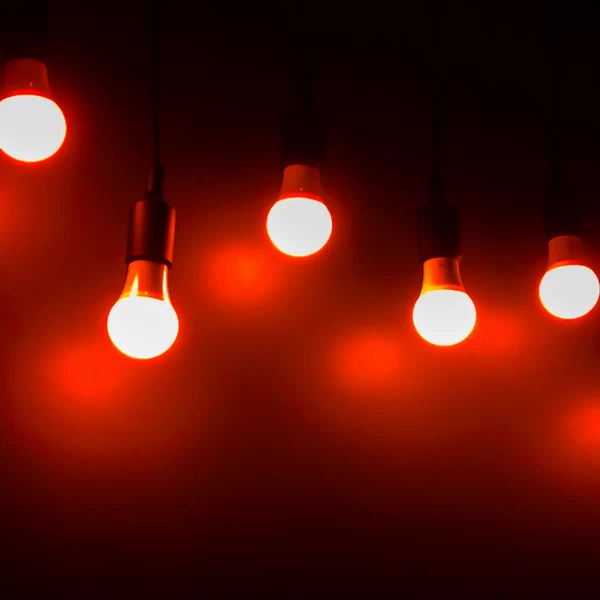
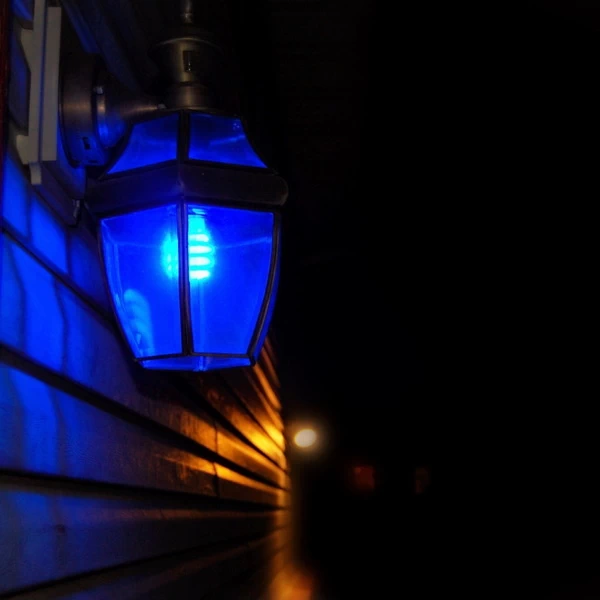
3. Do LED bulbs attract more bugs than other LED lights?
Whether LED bulb is more attract bugs depends on color temperature and wavelength of light, whether it contains UV components, and whether lights is sealed.It has nothing to do with type of LED bulb. Whether is LED bulb, LED panel light, LED floodlight, or LED light strip, their light source is essentially LED.
If your LED bulb has high color temperature, reaching cool white light above 6000K, it may attract more insects than ordinary LED lights because the blue light it emits is more attractive to bugs.
| Lighting Type | Is it likely to attract insects? | Description |
|---|---|---|
| LED bulbs (cool white) | Yes | Contains a lot of blue light, resulting in a harsh, bugs-attracting light. |
| LED bulb (warm white/red light) | Not easy | Warm colors are less attract bugs |
| LED enclosed lights | Determined by light type | Lampshade/grill design can reduce the attraction of bugs. For example, our industrial LED lights |
4. What Color Light Attracts Bugs?
The color of light plays a significant role in determining whether insects are attracted to it. According to research, bugs are more attracted to lights in the UV, blue, and violet spectrums. These types of lights resemble the colors found in natural sunlight, which insects use for navigation and finding food sources. Therefore, blue lights or even white lights can be more attractive to bugs.
Some common questions related to this topic include:
- Do black lights attract bugs? Yes.Although black lights are almost invisible to human eyes, but black lights emit UV light, which is highly attractive to insects.
- Do blue lights attract bugs? Yes. blue lights are among the most attractive to insects because they emit wavelengths that bugs can see clearly.
- Does white light attract bugs? Yes. but white light is less attractive than UV or blue light.
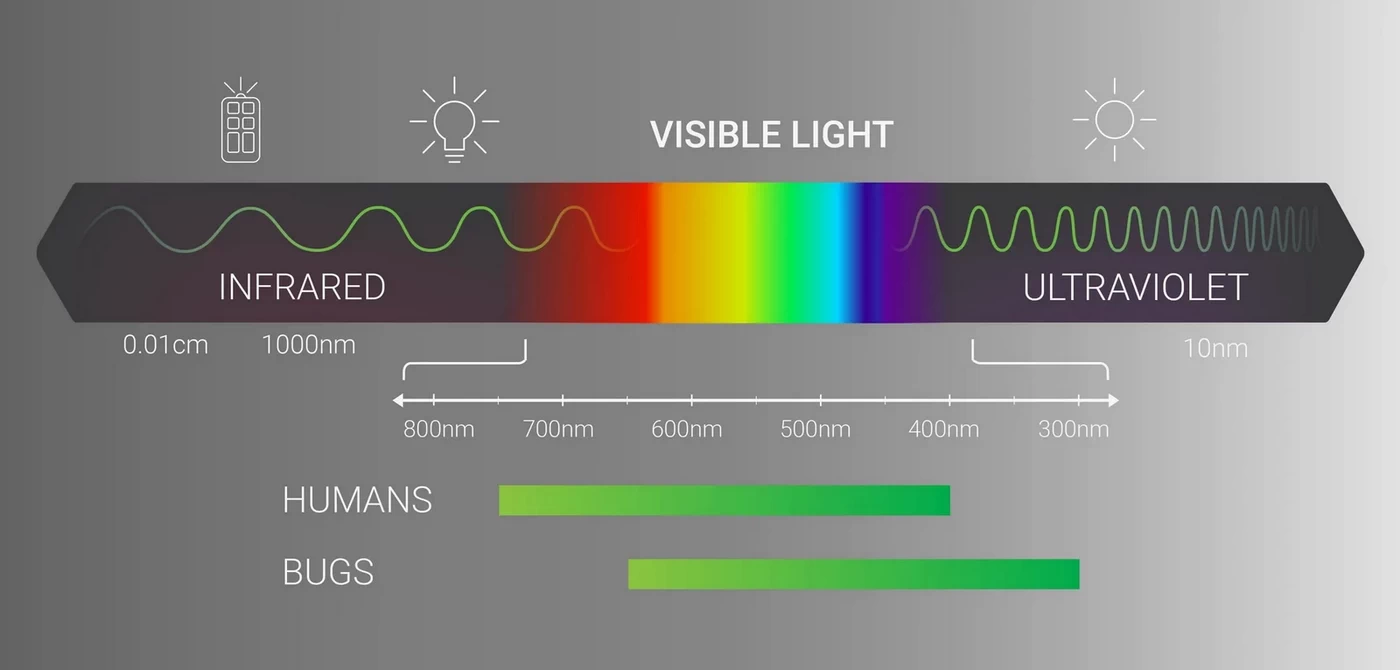
5. What Color Light Are Bugs Not Attracted To?
Certain colors of light are far less attractive to bugs, making them an excellent choice for outdoor and indoor environments where insect control is a priority. Bugs are not attracted to lights in the red or yellow spectrum. This is because most insects, particularly nocturnal species, are unable to see red light. Yellow light, such as that emitted by yellow bug light bulbs, is also less attractive to bugs.
The following colors of light are less likely to attract bugs:
- Red light: Insects cannot see red light well, making it less attractive.
- Yellow light: Often used in bug repellent light bulbs, yellow light is not attractive to bugs.
- Orange light: Like yellow, orange light is less visible to insects.
- Green light: Some insects are less sensitive to green light, though it’s not as effective as red or yellow.
For outdoor settings like porch lights or patio lighting, using yellow or red lights can help reduce insect activity. Yellow LED bug lights are commonly recommended for outdoor use as they are less attractive to insects than other colors.
6. Why Do Lights Attract Bugs?
Lights attract bugs primarily because insects are phototactic, meaning they use light to navigate. Many insects are attracted to sources of light, especially if it is bright or in the UV spectrum. The phenomenon known as positive phototaxis is the reason why you often see insects swarming around light sources, particularly in the evening.
However, not all lights attract bugs equally. Traditional lighting, such as incandescent bulbs and fluorescent tubes, tends to attract more insects because they emit UV light and generate a significant amount of heat. Bugs are more sensitive to these types of lights. By comparison, LED lights generally emit less UV light and produce less heat, making them a less attractive option for bugs.
What about heat?
While LED lights don’t emit as much heat as traditional lighting, they are not completely free from heat production. LED lights do warm up during operation, and this warmth can still attract bugs, especially in outdoor environments. However, compared to traditional lighting, the cooler nature of LED lights makes them less attractive to heat-seeking insects.
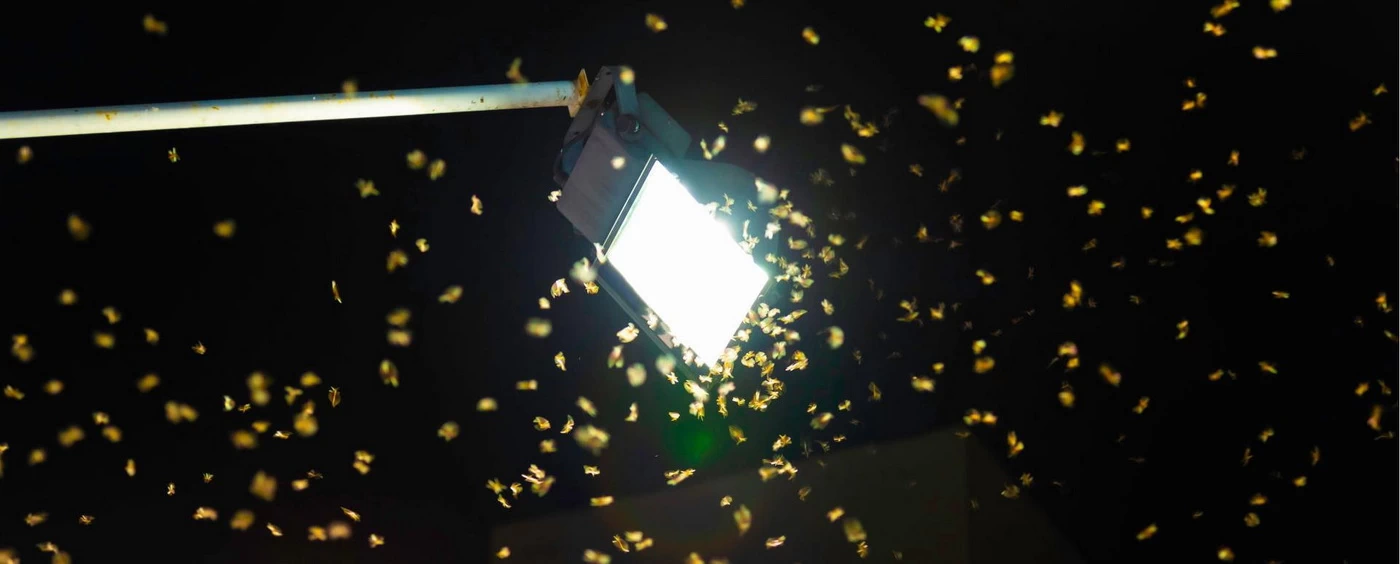
7. How Do Bugs Get in Light Fixtures?
One common issue with outdoor and indoor lighting, especially in commercial and industrial environments, is the problem of bugs getting into light fixtures. Insects, including flies, mosquitoes, and beetles, are often found trapped inside light fixtures. This problem can be exacerbated in settings like ports or stadiums where high-powered lighting is essential for visibility. Understanding how bugs get in light fixtures can help reduce their presence.
Bugs are attracted to light because many insects use natural light sources like the moon to navigate. Modern light fixtures, including LED outdoor bug lights, confuse these insects, causing them to circle or fly directly toward the light source. In some cases, bugs find their way inside light fixtures through small openings, cracks, or even ventilation slots, becoming trapped. Bug light bulbs or specialized anti-insect light bulbs can help minimize this issue, but proper fixture sealing is also essential.
Porch lights or outdoor lights are especially prone to attracting insects. Many insects are drawn to the heat and light emitted by fixtures, and once they enter, they can remain trapped. This is why it is crucial to ensure that fixtures are well-sealed and designed to prevent insect entry.
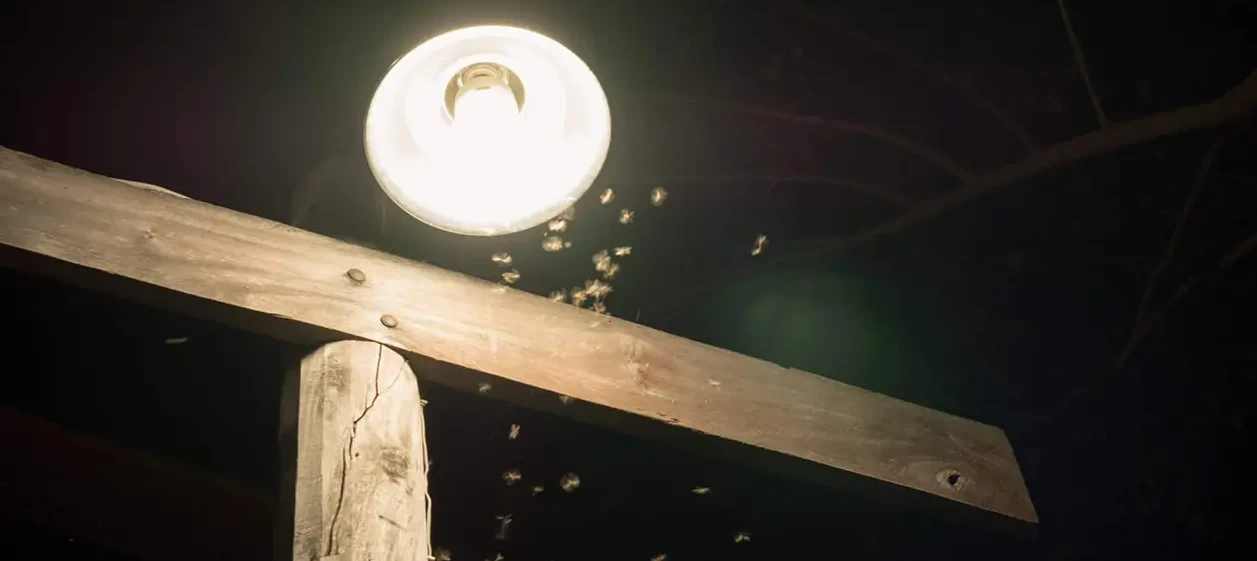
8. How to Get Rid of Light Bugs?
While LED lights are less likely to attract bugs compared to traditional lighting, you may still encounter some insect activity around your lights. There are several strategies to help you get rid of light bugs:
- Use insect-repellent light bulbs: Anti-insect light bulbs are designed to emit light that is less attractive to insects. Yellow bug lights or LED bug lights are popular options for this.
- Reduce brightness: Brighter lights are more likely to attract insects, so using dimmer settings or lower-lumen bulbs can help reduce bug activity.
- Use bug zappers: Bug zappers can be strategically placed around light sources to trap and eliminate bugs that are attracted to light.
- Install light fixtures with bug barriers: Modern outdoor light fixtures often come with barriers or shields to keep bugs out, helping to prevent insects from getting into the fixtures.
- Change the color of the light: As discussed earlier, using yellow or red lights can significantly reduce the number of bugs attracted to your lights. Yellow LED bug lights or anti-insect light bulbs are excellent options for outdoor settings.
- Use outdoor bug repellent systems: For large outdoor spaces like ports, stadiums, or industrial facilities, consider investing in insect-repellent lighting systems that use a combination of light and non-toxic repellents to keep bugs away.
9. Why can LED lamps from LEDRHYTHM reduce bugs?
Each lights of Ledrhythm is designed by a number of professional lighting designers. The light body is made of strong and durable materials with good heat dissipation effect, and the appearance conforms to the maximum heat dissipation structure design. The combination of the two makes the heat dissipation of the lamp achieve the best effect; because blue light is more attractive to insects, the light source of Ledrhythm lamps adopts low blue light processing technology, which can effectively reduce the radiation and output of ultraviolet (UV) and blue light in LED lamps, and can effectively avoid attracting more insects.
10. Conclusion
In conclusion, bugs and LED lights almost become one. While LED lights do attract fewer bugs than traditional lighting, they are not completely immune to attracting insects. The type of light, heat emission, and color spectrum play a significant role in determining whether bugs will be drawn to a light source. By choosing yellow or red LED lights, using insect repellent light bulbs, and employing strategies to reduce bug presence, you can significantly reduce the number of insects around your lighting fixtures.
To avoid bugs getting into light fixtures, it’s essential to use well-sealed, bug-resistant fixtures, especially in outdoor settings.
11. People Also Ask
Does LED Lights Attract Spiders?
LED lights don’t directly attract spiders, but they do indirectly.
Spiders prefer to build their webs near food sources, and the area around lights is a prime location. Because LED lights attract bugs, spiders tend to follow.
What Color Lights Attract Bugs?
First of all, ultraviolet light is the most attractive to insects. Secondly, blue and green lights will also attract insects. Other colors will attract fewer insects.
Are bugs and LED lights always a bad combination?
Not always. Bugs and LED lights can coexist, as long as you choose a right color temperature. Warm or amber LED lights are less likely to attract insects than cool white LED lights.
Why are bugs and LED lights discussed in outdoor lighting design?
Because bugs and LED lights can affect the experience and visibility of outdoor lighting, choosing LED lights with high sealing and strong heat dissipation can minimize the attract bugs, and improve user experience of gardens, streets and commercial spaces.


